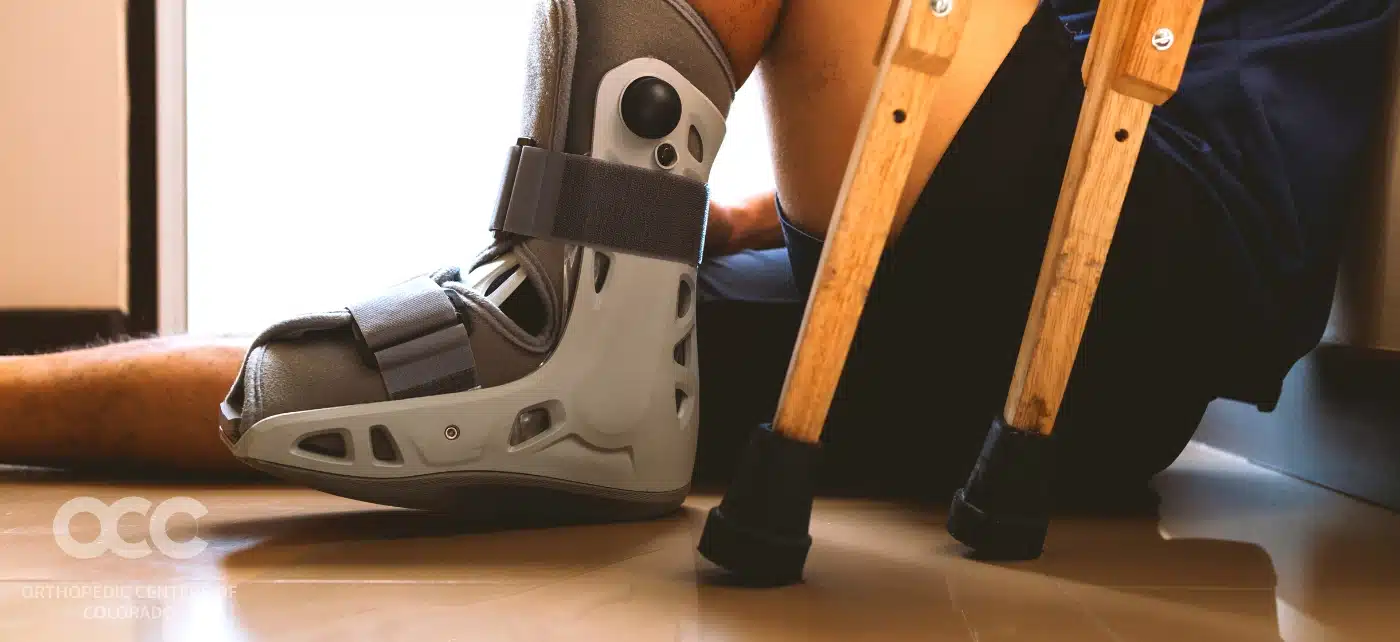There can be many different broken bones in your foot, but a talus fracture is a broken bone in your ankle. A talus fracture is a high-impact injury and can be very severe. It can result in a loss of motion and function of your ankle and foot joints. This can affect your ability to walk and bear weight on your foot. Not to mention people describe talus fractures as extremely painful. It doesn’t have to be so if you consult the orthopedic specialists at Advanced Orthopedics in Denver, Parker, and Aurora, Colorado. Their skill and experience can manage a talus fracture before it becomes irreversible. Let Advanced Orthopedics keep you on your feet.
OVERVIEW
The talus is the primary connection between the foot and leg. A talus fracture is a break in one of the bones that form the ankle. They usually occur due to high-impact injuries such as car accidents. Treatment usually requires surgery, and the recovery process can take months. Initially, the pain may not be bad enough to make you think there is a fracture. This sometimes leads people to put off getting an exam and treatment when early treatment would speed up recovery. Because the talus is essential for ankle movement, a fracture often results in substantial loss of motion and function.
ABOUT THE TALUS BONE
The talus is a small bone that sits between the heel bone (calcaneus) and the two bones of the lower leg (the tibia and fibula). It has an irregular, humped shape like a turtle’s shell. The bones of the lower leg ride on top and around the sides to form the ankle joint. Where the talus meets the foot bones, it forms the subtler joint. This joint is essential for walking on uneven ground. Besides connecting the foot to the leg and body, the talus helps transfer weight and pressure across the ankle joint.
DIFFERENT TYPES OF TALUS FRACTURE
The talus bone can break in different places and in different ways. Talus bone fractures include:
- Neck: The most common type of talar fracture occurs in the mid-section of the talus. This is called the neck. The neck is between the “body” of the talus, which is under the tibia by the ankle joint, and the “head” of the talus, which is farther down the foot.
- Lateral process: The outside of the talus bone is called the lateral process. This type of fracture occurs when the ankle is forced outward to the side. Lateral process talus fractures are commonly seen in snowboarders and are sometimes called “snowboarder fractures.”
- Avulsion fractures: A talar avulsion fracture occurs when a small part of the talus bone pulls away from the rest of the bone where it’s attached to a ligament or tendon.
- Stress fractures: A talar stress fracture is a small crack in the talus bone. This type of fracture happens because of overuse or repeated stress on the talus bone.
In more severe injuries, the talus can break and dislocate (come out of the joint), either at the ankle joint, the subtalar joint, or both. When this happens, a surgeon must put the bones and joints back in place as quickly as possible.
Talus fractures are classified by how much the talus or pieces of bone have moved out of their normal position. These classifications include:
- Minimally displaced or stable: The talus bone is only slightly out of place, and the broken ends of the bones still line up correctly or almost correctly. In this type of break, the bone is moved only slightly out of place. The fractured ends of the bone are still basically lined up correctly. The break can usually heal without surgery.
- Displaced (unstable): The talus bone breaks and the pieces move out of their normal position. Any time a bone moves out of its normal position, it’s called a displaced fracture. Highly displaced fractures are considered to be unstable. Surgery is typically required to get the broken parts of the talus to line up correctly again.
SYMPTOMS
The most common symptoms of a talus fracture include severe pain and swelling. Other symptoms may include:
- Difficulty walking.
- Inability to place weight on the foot.
- Bruising.
- Tenderness.
- Fracture blisters (fluid-filled blisters on your skin).
POTENTIAL COMPLICATIONS
A talus fracture can cause complex complications if left untreated or if it doesn’t heal correctly. These complications include:
- Posttraumatic arthritis: The talus bone is covered in cartilage. When the talus is injured, it also injures the cartilage around it. When your cartilage becomes uneven, it can lead to wear and tear in the joint. This can cause arthritis.
- Malunion: A malunion means the fractured bone healed in an abnormal position. A malunion can lead to long-term problems like difficulty walking.
- Nonunion: A nonunion means the fractured bone didn’t heal after an extended period.
- Avascular necrosis or osteonecrosis: Blood supply to your talus bone can be interrupted because of a fracture. Without the correct blood supply, your bone cells die. This can lead to the collapse of your bone.
NON-SURGICAL TREATMENTS
Treatment for a talus fracture depends on the type of fracture and the severity of the injury. First, a splint is used to keep the foot from moving. Casting may be recommended to hold together the bones in the foot and ankle while they heal. After the cast is removed, typically six to eight weeks later, rehabilitation will help restore the strength and function of the foot and ankle.
WHEN IS SURGERY INDICATED?
Because of the high force of the impact and injury that initially occurred, surgery is usually required to avoid severe damage. If the bone is broken into several pieces, a surgeon may perform an open reduction and internal fixation (ORIF). With an ORIF, bone fragments are put back in place and held together with a metal plate and/or screws until the bone heals. Patients may be placed in an external fixator if there’s too much swelling. With an external fixator, the surgeon will place large pins in the bones to hold them in place. The pins are visible from the outside of the skin and are held together with special bars. After the swelling goes down, the surgeon may try an ORIF again.
GETTING THE RIGHT DIAGNOSIS. GETTING THE RIGHT DOCTOR.
Talus fractures are complex; different types, different treatments, and different surgery. This means you want an orthopedic surgeon skilled and experienced in talus fractures. You’ll find the best ankle surgeons at Advanced Orthopedics in Denver, Parker, and Aurora, Colorado. During a physical examination, your surgeon will look at your foot and ask how the injury happened. They will generally check to see that the nerves of your foot are working correctly. Your surgeon will also check to see that the blood flow to your toes hasn’t been cut off and that you have normal muscle tension in your foot. They take care not to miss anything that could interfere with getting the best result. Imaging like X-rays and CT scans might be ordered to help pinpoint where the fracture is. This may also show whether the bones are still aligned (non-displaced fracture) or have shifted out of place (displaced fracture). Any loose bits of bone that may need to be removed also can be seen. At Advanced Orthopedics, they do it all. And just as importantly, always with care and understanding. Book an appointment now.










